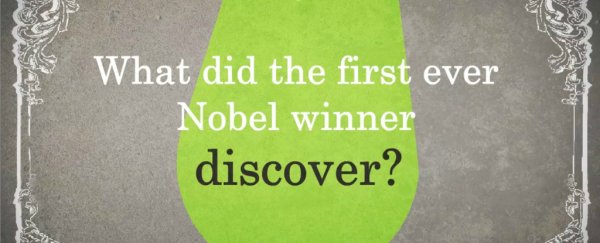Nobel season is almost upon us again, with the scientists behind the discovery of gravitational waves up for a prize - but have you ever wondered what the first-ever Nobel prize was handed out for?
Back in 1901, the King of Sweden gave Wilhelm Röntgen the inaugural Nobel Prize in Physics for the discovery of a mysterious new type of radiation.
As the Vikki Academy video above explains, at the end of the 19th century, society's obsession with magic had been replaced by all things electric and magnetic.
One of the most intriguing new concepts at the time was the cathode ray, which formed beams of electrons in a vacuum that could be diverted by magnets.
Fascinated with these cool little beams of electricity, Röntgen decided to mess around with them further, and put a vacuum tube containing cathode rays in a sealed box and turned out the light to see what would happen.
To his surprise, some kind of energy was escaping his box and lighting up a fluorescent cardboard screen behind it. Turns out, he'd found a brand new type of radiation - one that could pass through objects.
Having no idea what these rays were at the time, he called them - you guessed it - X-rays.
Röntgen and his wife Anna then tested all kinds of materials with this mysterious radiation, before discovering that X-rays couldn't travel through every type of substance - they couldn't travel through bone, for example.
But why? And how did X-rays result from Röntgen's cathode ray experiment anyway?
Cathode rays are high-energy beams of electrons trapped inside a glass-sealed vacuum - and when the electrons hit that glass, they excite the atoms, causing them to release particles of light, known as photons.
Röntgen didn't know it at the time, but photons come in different wavelengths, which reflect their energy. Blue photons, for example, are nearly twice as energetic as red photons.
But if you increase the voltage of the cathode ray enough, the electrons will hit the glass with so much energy that they release even more energetic photons: X-rays.
You're probably pretty familiar with how we use X-rays in medicine today, but since their discovery back in 1895, X-rays have also been used to discover the double helix of DNA, and figure out the structure of crystals.
Check out the video above to find out more about how Röntgen's experiment changed the world back in 1895, and to see just how cool X-rays really are.
You've got to admit, you have to respect someone who's brave enough to mess with the strange glowing light they see leaking out of a cardboard box. Nobel = well deserved.
